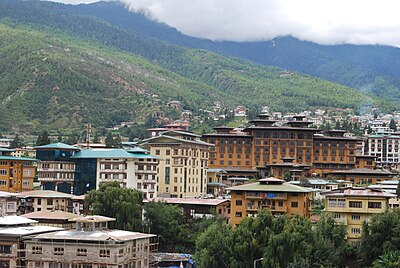
Search
Economy of Bhutan

The economy of Bhutan is based on agriculture and forestry, which provide the main livelihood for more than 60% of the population. Agriculture consists largely of subsistence farming and animal husbandry. Rugged mountains dominate the terrain and make the building of roads and other infrastructure difficult. Bhutan is among the richest by gross domestic product (nominal) per capita in South Asia, at $3,491 as of 2022, but it still places 153rd, and among the poorest in the world. The total gross domestic product is only $2,653 million, and 178th according to IMF.
Bhutan's economy is closely aligned with India's through strong trade and monetary links and dependence on India's financial assistance. Most production in the industrial sector is of the cottage industry type. Most development projects, such as road construction, rely on Indian migrant labour. Model education, social, and environment programs are underway with support from multilateral development organisations.
Each economic program takes into account the government's desire to protect the country's environment and cultural traditions. For example, the government, in its cautious expansion of the tourist sector, encourages visits by upscale, environmentally conscientious tourists. Detailed controls and uncertain policies in areas such as industrial licensing, trade, labour, and finance continue to hamper foreign investment. Hydropower exports to India have boosted Bhutan's overall growth, even though GDP fell in 2008 as a result of a slowdown in India, its predominant export market.
Since 1961, the government of Bhutan has guided the economy through five-year plans in order to promote economic development.
On 8 December 2023, Bhutan graduated from the UN's list of least developed countries (LDCs), making it only the 7th country to do so and the first in 3 years.
Macro-economic trend
This is a chart of trend of gross domestic product of Bhutan at market prices [1] by the International Monetary Fund:
Bhutan's hydropower potential and its attraction for tourists are key resources. The Bhutanese Government has made some progress in expanding the nation's productive base and improving social welfare.
In 2010, Bhutan became the first country in the world to ban smoking and the selling of tobacco. In order to stamp out cross-border smuggling during the pandemic, a new Tobacco Control Rules and Regulations (TCRR) 2021 allowed the import, sales and consumption of tobacco products.
Membership of economic organizations and agreements
In terms of trade, Bhutan is a member of the South Asian Free Trade Area (SAFTA) and the Bay of Bengal Initiative for Multi-Sectoral Technical and Economic Cooperation (BIMSTEC) and the South Asia Subregional Economic Cooperation (SASEC). Bhutan is also a member of the pan-Asian Asia Cooperation Dialogue (ACD), and the Asian Development Bank.
Bhutan first applied to join the WTO in 1999 and as an applicant, was quickly granted observer status Beyond that, ascension proceedings at the WTO have been much delayed and periodically put on pause, largely stemming from concerns and considerations of the Bhutanese government itself. The Bhutanese government approved ascension to the WTO in April 2023, at least partly hastened by the country's upcoming graduation from the UN-defined 'least developed country (LDC) category. Under WTO rules and processes, ascent of a country with LDC status comes with some leniency in certain requirements, more relaxed timeframes for compliance, and additional support; so, whilst the loss of LDC status, as happened in December 2023, was a reflection of Bhutan's success and development progress, it also meant much further delay in WTO ascension (that is, ascent after the loss of LDC status) would make the journey through to full WTO member status even harder.
GNH versus GDP
In the 1970s the King placed Gross National Happiness over Gross Domestic Product.
See also
- Agriculture in Bhutan
- Banking in Bhutan
- Mining in Bhutan
- Fishing in Bhutan
- Forestry in Bhutan
- Bhutanese ngultrum, currency
References
- Notes
- Public domain
- This article incorporates public domain material from The World Factbook. CIA.
- This article incorporates public domain material from U.S. Bilateral Relations Fact Sheets. United States Department of State.
- Citations
Further reading
- "The Economic Contribution of Copyright-Based Industries in Bhutan" (PDF). Intellectual Property Division, Ministry of Economic Affairs. Royal Government of Bhutan. October 2011. Archived (PDF) from the original on 4 June 2013.
- "Economic Development Policy" (PDF). Royal Government of Bhutan. December 2016. Archived (PDF) from the original on 9 October 2022.
- Shah, Sukhdev (1989). "Developing Bhutan's Economy: Limited Options, Sensible Choices". Asian Survey. 29 (8): 816–831. doi:10.2307/2644628. ISSN 0004-4687. JSTOR 2644628.
- Nayak, Sohini (7 February 2022). "The Bhutanese economic revival". ORF.
- Ranjan, Amit (17 February 2020). "Structural Transformation of Bhutan's Economy: Challenges Remain". National University of Singapore (NUS) Institute of South Asian Studies (ISAS).
External links
- Global Economic Prospects: Growth Prospects for South Asia The World Bank, 13 December 2006
Text submitted to CC-BY-SA license. Source: Economy of Bhutan by Wikipedia (Historical)
Articles connexes
- Bhutanese ngultrum
- Gross National Happiness
- Bhutan
- Slavery in Bhutan
- Forestry in Bhutan
- Bank of Bhutan
- Bhutan–India relations
- Royal Monetary Authority of Bhutan
- People's Democratic Party (Bhutan)
- List of districts of Bhutan by Human Development Index
- Mining in Bhutan
- Economy of South Asia
- List of prime ministers of Bhutan
- King of Bhutan
- Economy of India
- Index of Bhutan-related articles
- Fishing in Bhutan
- South Asian Free Trade Area
- Tala Hydroelectric Power Station
- Energy in Bhutan
Owlapps.net - since 2012 - Les chouettes applications du hibou


